Root Remediation
Focusing on whats under the ground
Root Remediation
Trees and shrubs suffering from shallow soil compaction (typically due to pedestrian use or vibrations caused by vehicular traffic,) or lacking vigorous root growth due to poor topsoil quality (lack of organic matter, nutrients, beneficial organisms, or aeration) are ideal candidates for Root Remediation by means of air tilling. Since most of a tree’s roots proliferate near the surface where they have the best access to oxygen and nutrients, air tilling is excellent at promoting robust and uniform root growth.
Below is the Root Remediation process performed on an Oak tree in a severely compacted lawn
1. Sod around the tree is removed.
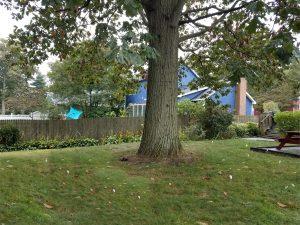
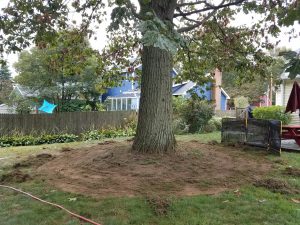
2. Using the specialized air tool, the compacted soil is broken apart, aerated, and a soil amendment is mixed in.
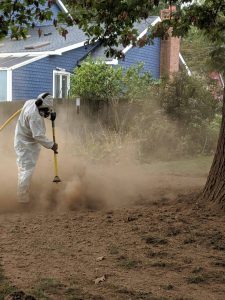
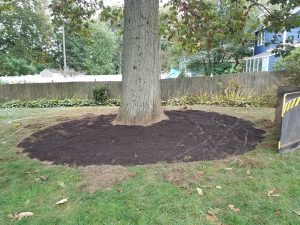
3. Any issues found in the root system are able to be dealt with at this point.
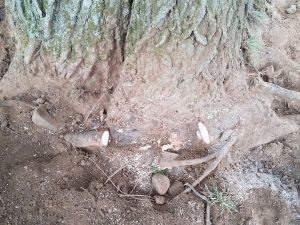
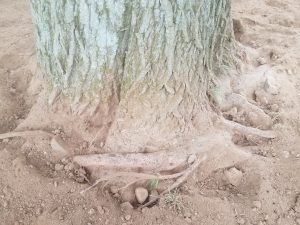
4. Finally, the area is finished with mulch.
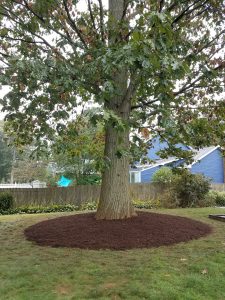
Radial Trenching
This is done to modify soil composition, improve aeration, and encourage root growth to moderate depths. It is especially effective when trees have a shallow depth of viable soil or anaerobic conditions. Additionally, this application can be useful in planting areas where minimal disturbance is desired.
This technique has shown to encourage deep root growth far-reaching from the trunk and between structural root leaders. Established trees that are struggling to survive in poor soils may benefit from a long-term strategy in which radial trenching is performed several times and over the course of several years to make more extensive improvements to a tree’s soil.
Vertical Mulching
Vertical mulching is done to de-compact and augment soil deep into the tree root zone. This application is especially useful in areas with poor drainage, shallow or impervious soils, or shared by perennial or ground-cover plantings where minimal disturbance is desired. Aeration and soil amendments from vertical mulching can encourage roots to grow deep into the soil profile, thereby improving the tree’s stability and volume of viable growing medium. Because vertical mulching affects the deepest soil profile, it is recommended for sites with shallow soil depth, hard-pan, anaerobic conditions, or other types of poor growing soils.
Root Collar Excavation
Trees commonly suffer when the grade is set too high against their root flare or root collar. This can occur when trees are planted at the wrong depth (too low) or when trees subside due to improper compaction below the root ball when they are planted. Alternatively, root collars can be buried during construction on a property (Back-filling) or over time due to the accumulation of mulch or soil around the tree. Whatever the cause, harm to the tree from grade set above the root collar can be long-lasting and should be corrected through root collar excavation.
Symptoms of this condition include rot or infection of bark at the base of the trunk, growth of roots that are too high relative to the natural root flare, and girdling roots, which constrict the root flare and tree trunk. Girdling can also occur on urban sites, where roots have limited room to grow or have encountered compacted or anaerobic soil conditions, causing roots to heave around the collar. This procedure allows tree root collars and girdling roots to be excavated with minimal damage to the tree. Once uncovered, the licensed arborist can easily identify roots that need to be removed or trained.
Root Pruning
Construction or maintenance work that makes intrusions into a tree’s root zone will benefit from this procedure. Air-spading is safe to the tree’s roots and a highly efficient method to perform exploratory excavation to locate existing roots and utilities. Almost any site work operations – including the building of foundations, pavements, drainage infrastructure, and utilities – present ideal opportunities for air-spading and root pruning.
Proper root pruning will encourage future growth and minimize negative impacts to structures or utilities. Once the existing roots have been excavated, the licensed arborist can easily determine the best places to make clean cuts using a hand pruner.
For more information click the following link where you can view videos of some of these different services we offer.
https://www.airspade.com/reference-library/instructional-videos